Legal status Georgia Non-Profit Website beltline.org | Location Atlanta, Georgia Founded April 2005 | |
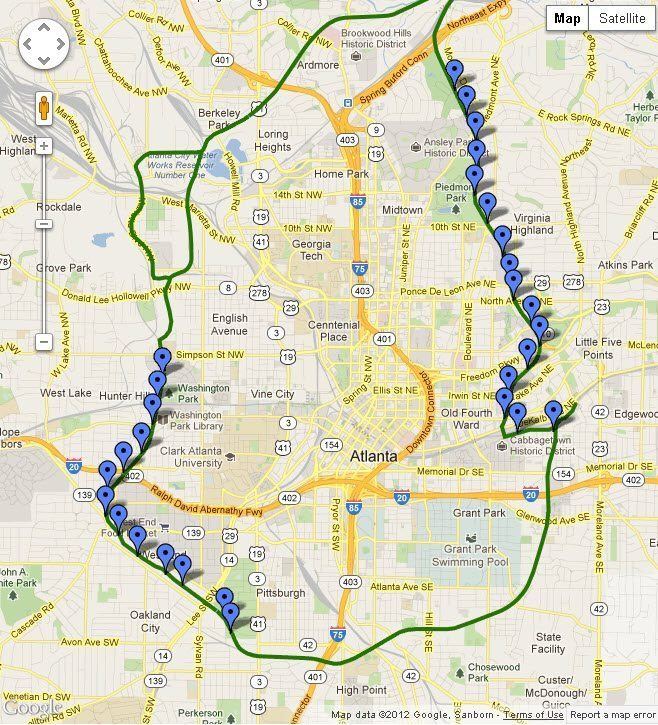 | ||
Formation April 2005
(12 years ago) Purpose Urban redevelopment and mobility President and Chief Executive Officer (ABI,) Executive Director (ABP) Paul Morris (ABI) Rob Brawner (ABP) Motto Where Atlanta Comes Together Main organ Atlanta BeltLine Partnership Profiles | ||
Mud creek near the brick works along the beltline trail
The BeltLine (also Beltline or Belt Line) is a former railway corridor around the core of Atlanta, Georgia, under development in stages as a multi-use trail. Some portions are already complete, while others are still in a rough state but hikeable. Using existing rail track easements, the BeltLine is designed to improve transportation, add green space, and promote redevelopment. There are longer-term visions for streetcar or light-rail lines along all or part of the corridor.
Contents
- Mud creek near the brick works along the beltline trail
- Rail removal for atlanta s beltline
- Concept
- Park component
- Multi use trails
- Transit elements
- Art
- Usage issues
- Discontinuities
- History
- Timeline
- Forthcoming
- References

The BeltLine plan was originally developed in 1999 as a masters thesis by Georgia Tech student Ryan Gravel. It links city parks and neighborhoods, but has also been used for temporary art installations. In 2013, the project received a federal grant of $18 million to develop the southwest corridor.
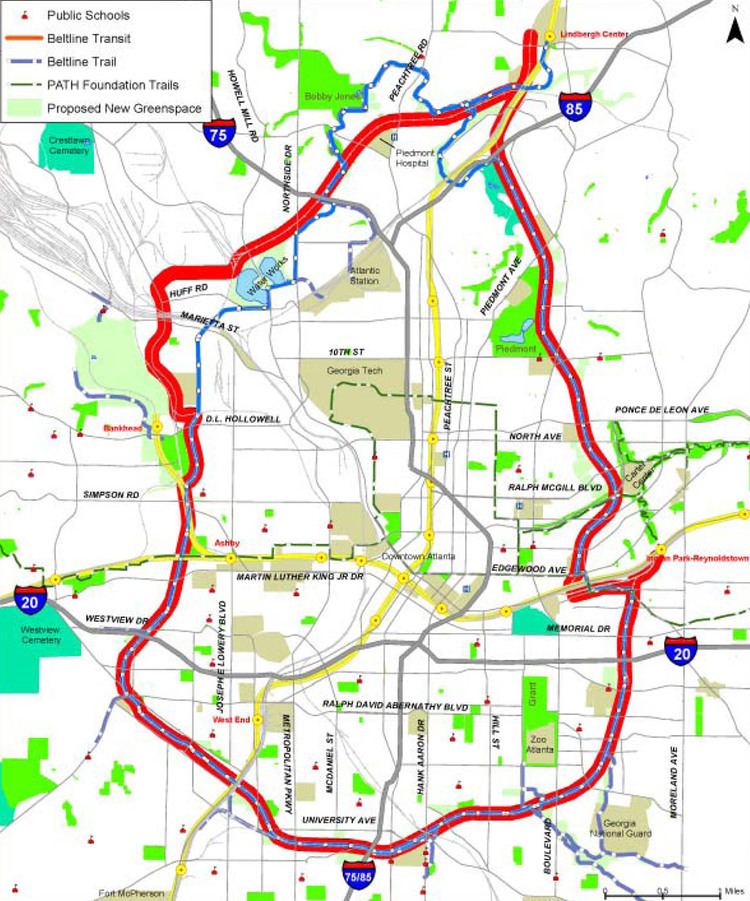
Rail removal for atlanta s beltline
Concept

The idea originated in a 1999 master's degree thesis by Georgia Tech student Ryan Gravel, who founded the non-profit Friends of the Belt Line and works for Perkins+Will. Frustrated with the lack of transportation alternatives in Atlanta, Gravel and two of his colleagues, Mark Arnold and Sarah Edgens, summarized his thesis in 2000 and mailed copies to two dozen influential Atlantans. Cathy Woolard, then the city council representative for district six, was an early supporter of the concept. Woolard, Gravel, Arnold, and Edgens spent the next several months promoting the idea of the BeltLine to neighborhood groups, the PATH foundation, and Atlanta business leaders. Supported by Atlanta mayor Shirley Franklin, previous city council president Cathy Woolard, and many others in Atlanta's large business community, the idea grew rapidly during 2003 and 2004.

The railroad tracks and rights-of-way are owned mostly by CSX Transportation, Norfolk Southern, and the Georgia Department of Transportation. Developer Wayne Mason had purchased most of the NS portion, in anticipation of the BeltLine, but later sold it after conflict with the city.
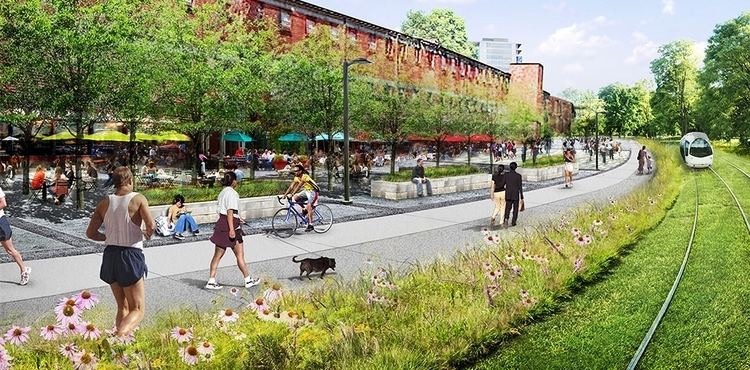
The total length will be 22 miles (35 km), running about 3 miles (5 km) on either side of Atlanta's elongated central business district. It is planned to include a neighborhood-serving transit system (likely streetcars); footpaths for non-motorized traffic, including bicycling, rollerskating, and walking; and the redevelopment of some 2,544 acres (1,030 ha). The project (although not the funding for it) is included in the 25-year Mobility 2030 plan of the Atlanta Regional Commission for improving transit. As of 2014, the project's planners estimated they had 17 years left before the project would be completed, and no light-rail lines had yet been built.
Park component

The BeltLine plan calls for the creation of a series of parks throughout the city creating what the working plan, The Beltline Emerald Necklace, calls the thirteen "Beltline Jewels"; they would be connected by the trail and transit components of the plan. In total, the BeltLine will create or rejuvenate 1,300 acres (530 ha) of greenspace. The Trust for Public Land first identified areas that would be appropriate for parkland, and spurred the inclusion of the park component in the current plan. The Trust is active in acquiring land for the project, which it intends to sell to the city after bonds have been issued from the beltline tax-allocation district.
The plan would expand these existing parks:
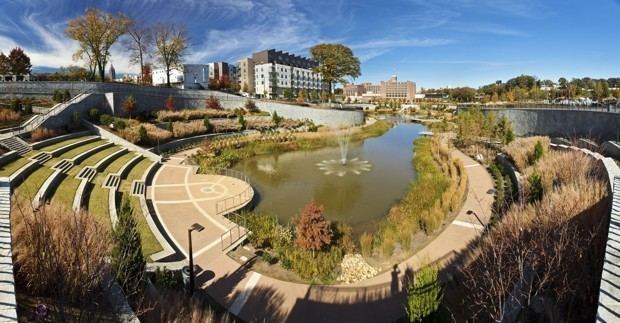
It would also create these new parks:

Multi-use trails
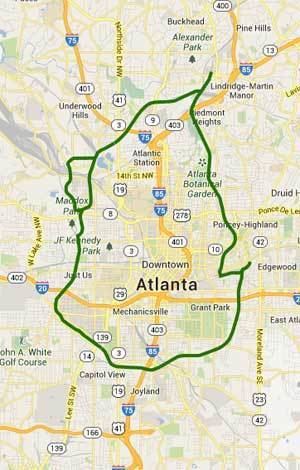
The BeltLine will feature a continuous path encircling the central part of the city, generally following the old railroad right of way, but departing from it in several areas along the northwest portion of the route. In total, 33 miles (53 km) of multi-use paths are to be built, including spur trails connecting to neighborhoods. The PATH Foundation, which has many years of experience building such trails in the Atlanta area, is a partner in the development of this portion of the system.
Transit elements
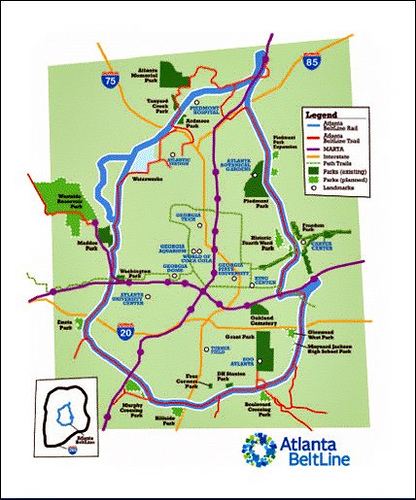
The original focus of the BeltLine thesis was on establishing a 22-mile (35 km) light rail loop around the central portion of the city. The vision has expanded to include trails, parks and greenspace, streetscapes, public art, affordable housing, economic development, environmental sustainability, and historic preservation. In Summer 2012, there was a referendum on whether a 1-cent sales tax (SPLOST) should be implemented to fund traffic and road improvements. If approved, the tax would have funded several streetcar routes along portions of the BeltLine trail and connections to MARTA stations and the Downtown Loop streetcar. The sales tax did not pass.
In 2013, Atlanta BeltLine, Inc. (ABI) entered into a services agreement with the City of Atlanta to advance key transportation projects that support the BeltLine’s success. The first order of business was the Atlanta Streetcar Extension environmental review, and federal environment reviews are now underway for Atlanta BeltLine East, Atlanta BeltLine West, and the Crosstown-Midtown Streetcar, in addition to the Atlanta Streetcar Downtown Extension.
Art
"Art on the Atlanta BeltLine" is the city of Atlanta's largest temporary public art exhibition that showcases the work of hundreds of visual artists, performers, and musicians along nine miles (14 km) of the BeltLine corridor. The first exhibition was in 2010.
Usage issues
While the Metropolitan Atlanta Rapid Transit Authority (which runs the MARTA system) is excited about the surface-level addition to its existing above-ground and subway system, GDOT has reservations, as the lines it previously purchased were intended for use as commuter rail connections. CSX also is concerned, as passenger trains would have to pass through a major regional railyard, intermingling with freight trains and possibly causing issues of delays and potential legal liability.
In late January 2009, GDOT and Amtrak made an unannounced and last-minute filing with the Surface Transportation Board that would effectively block the northeast part of the BeltLine, instead taking it for future intercity rail. However, this conflict was later resolved.
Discontinuities
There are five gaps along the BeltLine where rights of way do not connect and thus create larger challenges to the project.
- Armour — Near the Lindbergh Center MARTA station, bisected by two active rail lines. Solving this would involve transit sharing the rail right-of-way and splitting off the trail where Clear Creek joins Peachtree Creek, following Clear Creek around the Armour warehouse properties then tunneling under the active rail lines and I-85 to the Ansley Golf Course then rejoining the BeltLine.
- CSX Hulsey Yard — Near the Inman Park/Reynoldstown MARTA station. A workaround for the trail is to utilize the existing tunnel at Krog Street.
- Bill Kennedy Way (also known variously as the Glenwood-Memorial Connector and the Glenwood-Wylie Connector) — a bridge spanning I-20 between Glenwood Park/Ormewood Park and Reynoldstown. The proposed fix here is to widen the bridge enough to support trail, transit and motor traffic.
- Washington Park to Simpson Rd — near the Ashby MARTA station. Proposals include a span over the MARTA tracks or possibly share the right of way.
- Bankhead — The largest gap is near Maddox Park and involves one of the busiest rail corridors in the state. Proposals include 1) taking the trail east to cross under Hollowell Pkwy; 2) diverting through Mead property at Marietta Blvd; or 3) sharing the road with Lowery (formerly Ashby Street).
History
The first development of the BeltLine area began when the Atlanta & West Point Railroad began building a 5-mile (8 km) connecting rail line from its northern terminus at Oakland City to Hulsey Yard on the Georgia Railroad (essentially the southeast quarter of the completed BeltLine). The surveys were done and initial construction had begun when the courts ordered a halt in May 1899 as that work did not fall under the A&WP's charter.
In September 1899, a more ambitious charter for an Atlanta Belt Railway Company was announced that would circle the entire city connecting all rail lines so that freight car transfers could occur on the outskirts rather than downtown. The initial charter was to encompass no more than 30 miles (48 km) and named only perimeter points Howell and Clifton Stations. Since Clifton was in DeKalb County, both it and Fulton were named in the charter. After surveys of the route and right of way acquisitions, the DeKalb portion was ditched leaving the entire route in Fulton County. The entire line was completed by 1902.
